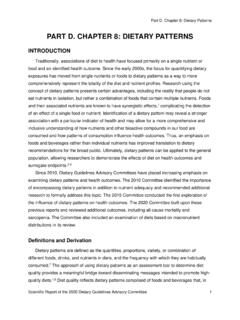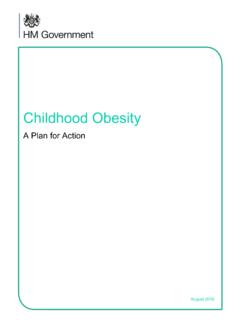Transcription of The Dietary Guidelines for Americans 2015-2020
1 NDEP Webinar SeriesThe Dietary Guidelines for Americans 2015-2020 What Are They, How Have They Changed, and How Can You Use Them in Practice?WelcomeBetsy Rodr guez, RN, MSN, CDE Deputy DirectorNational Diabetes Education ProgramDivision of Diabetes TranslationCenters for Disease Control and PreventionIntroduction Managing a chronic disease like diabetes requires multiple decisions each day on a range of complex processes. There are no vacations, no time-outs. What can I eat? This is the most common question from people with diabetes. Nutrition plays an important role in controlling or preventing diabetes. Learning Objectives Explain the purpose of the Dietary Guidelines for Americans (DGA), how they have changed, and how they should be used in diabetes education. Describe the impact that changes to the Dietary Guidelines can have on the broader public health nutrition world. Name the tools to apply the recommendations in public health.
2 Identify aspects of culture that can facilitate the use of the Dietary guidelinesKnowledge Check The main theme of the Dietary Guidelines2015 2020 is:A. Importance of eating patterns as a whole; combination of foods and drinks that people consume over It s comparison of how Americans are eating now against recommendations, providing data by age groups and Information about shifts (healthy substitutions in food choices) for achieving healthy eating All ofthe above Knowledge CheckHistory 1917194311917956197919801985199019952000 200520102015 Knowledge Check What s changed in the Dietary Guidelines 2015 2020? longer have a quantitative requirement for Dietary sugar quantitative on food pattern rather than individual nutrients and specific of the has changedKnowledge CheckToday s PresentersJennifer Seymour, PhDSenior Policy AdvisorDivision of Nutrition, Physical Activity, and ObesityCenters for Disease Control and PreventionLorena Drago, MS, RD, CDN, CDE FounderHispanic FoodwaysJennifer Seymour, PhDDIETARY Guidelines FOR Americans 2015-2020 Dietary Guidelines for Americans 2015-2020 What It Is, What It Is Not Provide evidence-based recommendations about the components of a healthy and nutritionally adequate diet Focus on disease prevention rather than disease treatment Inform Federal food, nutrition, and health policies and programsDietary Guidelines for Americans 2015-2020 Figure 1-3 Dietary Guidelines for Americans 2015-2020 Contents Executive Summary Introduction Chapter 1.
3 Key Elements of Healthy Eating Patterns Chapter 2: Shifts Needed to Align With Healthy Eating Patterns Chapter 3: Everyone Has a Role in Supporting Healthy Eating Patterns AppendixesDietary Guidelines for Americans 2015-2020 The a healthy eating pattern across the lifespan. All food and beverage choices matter. Choose a healthy eating pattern at an appropriate calorie level to help achieve and maintain a healthy body weight, support nutrient adequacy, and reduce the risk of chronic on variety, nutrient density, and amount. To meet nutrient needs within calorie limits, choose a variety of nutrient-dense foods across and within all food groups in recommended calories from added sugars and saturated fats and reduce sodium intake. Consume an eating pattern low in added sugars, saturated fats, and sodium. Cut back on foods and beverages higher in these components to amounts that fit within healthy eating to healthier food and beverage choices.
4 Choose nutrient-dense foods and beverages across and within all food groups in place of less healthy choices. Consider cultural and personal preferences to make these shifts easier to accomplish and healthy eating patterns for all. Everyone has a role in helping to create and support healthy eating patterns in multiple settings nationwide, from home to school to work to Guidelines for Americans 2015-2020 The Guidelines (cont.)Key Elements of Healthy Eating Patterns:Key Recommendations Consume a healthy eating pattern that accounts for all foods and beverages within an appropriate calorie level. A healthy eating pattern includes: A variety of vegetables from all of the subgroups dark green, red and orange, legumes (beans and peas), starchy, and other Fruits, especially whole fruits Grains, at least half of which are whole grains Fat-free or low-fat dairy, including milk, yogurt, cheese, and/or fortified soy beverages A variety of protein foods, including seafood, lean meats and poultry, eggs, legumes (beans and peas), and nuts, seeds, and soy products Oils A healthy eating pattern limits: Saturated fats and transfats, added sugars, and sodiumKey Elements of Healthy Eating Patterns:Key Recommendations (cont.)
5 Key recommendations that are quantitative are provided for several components of the diet that should be limited. These components are of particular public health concern in the United States, and the specified limits can help individuals achieve healthy eating patterns within calorie limits: Consume less than 10 percent of calories per day from added sugars Consume less than 10 percent of calories per day from saturated fats Consume less than 2,300 milligrams (mg) per day of sodium If alcohol is consumed, it should be consumed in moderation up to one drink per day for women and up to two drinks per day for men and only by adults of legal drinking age Meet the Physical Activity Guidelines for AmericansPrinciples of Healthy Eating Patterns An eating pattern represents the totality of all foods and beverages consumed It is more than the sum of its parts; the totality of what individuals habitually eat and drink act synergistically in relation to health.
6 Nutritional needs should be met primarily from foods rather than with supplements Individuals should aim to meet their nutrient needs through healthy eating patterns that include foods in nutrient-dense forms. Healthy eating patterns are adaptable Any eating pattern can be tailored to the individual s socio-cultural and personal Science Behind Healthy Eating Patterns Systematic reviews of scientific research To examine relationships between the overall eating pattern, including its constituent foods, beverages, and nutrients, and health outcomes. Food pattern modeling To assess how well various combinations and amounts of foods from all food groups would result in healthy eating patterns that meet nutrient needs and accommodate limits, such as those for saturated fats, added sugars, and sodium. Analyses of current intakes To identify areas of potential public health Healthy Eating Patterns:Food Groups Examples of Content Vegetables Include a variety of vegetables from all five subgroups dark green, red and orange, legumes (beans and peas), starchy, and other.
7 Include all fresh, frozen, canned, and dried options in cooked or raw forms, including vegetable juices. Vegetables should be consumed in a nutrient-dense form, with limited additions such as salt, butter, or creamy sauces. Dairy Include fat-free and low-fat (1%) dairy, including milk, yogurt, cheese, or fortified soy beverages (soymilk). Fat-free or low-fat milk and yogurt, in comparison to cheese, contain less saturated fats and sodium and more potassium, vitamin A, and vitamin Healthy Eating Patterns:Other Components In addition to the food groups, it is important to consider other food components when making food and beverage choices. Added sugars Saturated fats Transfats Cholesterol Sodium Alcohol CaffeineInside Healthy Eating Patterns:Other Components Examples of Content Cholesterol Individuals should eat as little Dietary cholesterol as possible while consuming a healthy eating pattern. The Healthy Eating Pattern contains approximately 100 to 300 mg of cholesterol across the 12 calorie Most caffeine evidence focuses on coffee.
8 Three to five 8-oz cups/day can be included in healthy eating patterns. Individuals who do not consume caffeinated beverages are not encouraged to add them. In addition, caffeinated beverages may contain added calories from cream, whole or 2% milk, creamer, and added sugars, which should be Eating Patterns:Detailed InformationCall-out boxes provide details on many topics: Healthy physical activity patterns Importance of calorie balance About legumes (beans and peas) How to make half of grains whole grains About seafood About meats and poultry Dietary fats the basics Dietary Approaches to Stop Hypertension (DASH) CaffeineHealthy Eating Patterns:Multiple Approaches There are many ways to consume a healthy eating pattern, and the evidence to support multiple approaches has expanded over time. Examples of healthy eating patterns in the Dietary Guidelinesinclude: Healthy Eating Pattern Healthy Mediterranean-Style Eating Pattern Healthy Vegetarian Eating Pattern Current Eating Patterns in the United States% Population 1 yrBelow, At, or Above Each Dietary Goal or Limit (Fig 2-1)Note: The center (0) line is the goal or limit.
9 For most, those represented by the orange sections of the bars, shifting toward the center line will improve their eating Source:What We Eat in America, NHANES 2007-2010 for average intakes by age-sex group. Healthy Food Patterns, which vary based on age, sex, and activity level, for recommended intakes and and Refined Grains: Intakes and RecommendationsAverage Intakes Compared to Ranges of Recommendations and Limits (Figure 2-5)Note: Recommended daily intake of whole grains is to be at least half of total grain consumption, and the limit for refined grains is to be no more than half of total grain consumption. The blue vertical bars on this graph represent one half of the total grain recommendations for each age-sex group, and therefore indicate recommendations for the minimum amounts to consume of whole grains or maximum amounts of refined grains. To meet recommendations, whole grain intake should be within or above the blue bars and refined grain intake within or below the Sources: What We Eat in America, NHANES 2007-2010 for average intakes by age-sex group.
10 Healthy Food Patterns, which vary based on age, sex, and activity level, for recommended intake : Intakes and RecommendationsAverage Weekly Intakes Compared to Ranges of Recommendations (Fig 2-6)Data Sources: What We Eat in America, NHANES 2007-2010 for average intakes by age-sex group. Healthy Food Patterns, which vary based on age, sex, and activity level, for recommended intake rangesShifts to Align with Healthy Eating Patterns:Examples Increasing vegetablesin mixed dishes while decreasing the amounts of refined grains or meats high in saturated fat and/or sodium. Incorporating seafoodin meals twice per week in place of meat, poultry, or eggs. Using vegetable oilin place of solid fats when cooking, and using oil-based dressings and spreads on foods instead of those made from solid fats. Choosing beverages with no added sugars, such as water. Using the Nutrition Facts label to compare sodiumcontent of foods and choosing the product with less Messages from Chapter 2 The population, across almost every age and sex group, consumes eating patterns that are: low in vegetables, fruits, whole grains, dairy, seafood, and oil high in refined grains, added sugars, saturated fats, sodium, and for some age-sex groups, high in the meats, poultry, and eggs subgroup.















